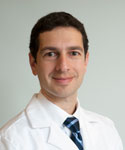 Eli Miloslavsky, MD, is co-founder of the Vasculitis and Glomerulonephritis Center at Massachusetts General Hospital and an instructor of medicine at Harvard Medical School, both in Boston. His research has focused on improving education for rheumatology fellows. He recently agreed to answer a few questions for The Rheumatologist and eNewsRheum.
Eli Miloslavsky, MD, is co-founder of the Vasculitis and Glomerulonephritis Center at Massachusetts General Hospital and an instructor of medicine at Harvard Medical School, both in Boston. His research has focused on improving education for rheumatology fellows. He recently agreed to answer a few questions for The Rheumatologist and eNewsRheum.
Question: You’ve researched the barriers between internal medicine (IM) subspeciality fellows and IM residents. What are your most important takeaways from that work?
Answer: First, fellows enjoy teaching residents when they get a chance to do it, and residents really value fellow teaching, especially on the wards, where their formal learning opportunities may be limited. However, in the hospital environment, many barriers stand in the way of that teaching interaction. Not all of the barriers relate to workflow-based issues, such as the workload of residents and fellows, and disparate rounding schedules. Other barriers—such as residents perceiving that fellows may be too busy to teach them and vice versa—that prevent the teaching interaction from taking place are equally important, and many of these barriers are amenable to intervention.
Q: You developed the Fellow as Clinical Teacher (FACT) curriculum to enhance fellows’ ability to push through barriers to teach during consultation. How valuable is this type of approach?
A: We developed the FACT curriculum to specifically address the challenges fellows face when teaching on the in-patient consult service, including the limited time available to teach and not knowing their learners, among others.1 We have evaluated the FACT curriculum in multiple rheumatology fellowship programs, as well as in other subspecialties. Our studies have demonstrated that the FACT curriculum improves fellows’ teaching skills in this setting and makes them more likely to engage in teaching. Increasing fellow teaching on the wards may have a potentially broad positive impact, including enhancing communication between teams, thereby improving patient care; improving rheumatology knowledge among residents through learning and among fellows through teaching; and even helping residents consider a career in rheumatology.
Q: Can your FACT pilot be replicated elsewhere?
A: The FACT curriculum can be administered in any fellowship program. We have provided our curriculum materials to a number of fellowship programs that have successfully implemented the curriculum with their fellows. The curriculum focuses on two major aspects of teaching during consultation: 1) Overcoming barriers to teaching in the setting of inpatient consultation, such as time constraints, and hospital-based barriers such as communication, among others. And 2) developing an effective technique for teaching during consultation, a setting that can make it challenging to assess your learner, their interests, strengths and knowledge gaps. Using video examples, data from our research and a novel framework, called the PARTNER framework, that we developed for teaching during consultation, the curriculum helps fellows overcome barriers to teaching and use the teaching opportunities they are able to create effectively and efficiently.
Q: In a world in which healthcare and technology seem to be changing so quickly, has education adapted quickly enough?
A: Medical education has certainly made considerable strides in recent years. However, there is a long way to go in order to shift the focus of medical education from information delivery—which is becoming less critical, given the ready access to information that most learners have—to helping learners become effective critical thinkers and life-long learners. Further, in graduate medical education, it is difficult to devote time to learning due to patient care demands. Taking advantage of the teachable moment that exists in every consultation request is a tremendous opportunity to enhance learners’ clinical reasoning skills and enhance workplace-based learning.
Q: What changes would you make to rheumatology education going forward, particularly as the specialty needs to attract more residents?
A: There are many attractive aspects to our field; however, students and residents often have little exposure to rheumatology and may be further dissuaded from considering the field by their relative lack of clinical skill and knowledge about our specialty in comparison with other subspecialties. Maximizing rheumatology teaching opportunities during medical school and residency is an important component of the effort to attract trainees to rheumatology. Studies have shown that subspecialty fellows have an impact on internal medicine resident career choice.2,3 Fellows have the most opportunity to interact with students and residents during inpatient consultation. Therefore, enhancing fellow teaching skills may make an impact on attracting residents to our specialty. Speaking from personal experience, I began to consider a career in rheumatology in large part because the rheumatology fellows I consulted as an intern were great teachers and did a great job conveying their enthusiasm for the specialty.
Richard Quinn is a freelance writer in New Jersey.
References
- Miloslavsky EM, Criscione-Schreiber LG, Jonas BL, et al. Fellow as teacher curriculum: Improving rheumatology fellows’ teaching skills during in-patient consultation. Arthritis Care Res (Hoboken). 2016 Jun;68(6):877–881. doi: 10.1002/acr.22733.
- Horn L, Tzanetos K, Thorpe K, et al. Factors associated with the subspecialty choices of internal medicine residents in Canada. BMC Med Educ. 2008 Jun 26;8:37.
- Kolasinski SL, Bass AR, Kane-Wanger GF, et al. Subspecialty choice: Why did you become a rheumatologist? Arthritis Rheum. 2007 Dec 15;57(8):1546–1551.



